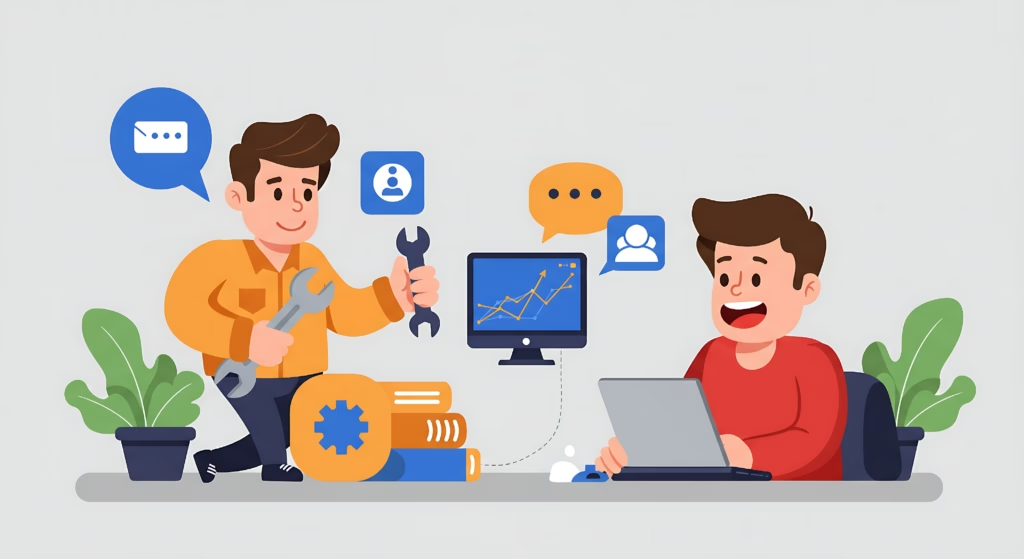How Your Phone System Can Generate ROI and Revenue (Not Just Cost Money)
Many business owners view their phone system as a necessary expense—just another bill to pay each month. But what if your phone system could actually contribute to your bottom line instead of merely draining it? Businesses that optimize their communication systems can transform this traditional cost center into a revenue-generating asset.
Phone systems have evolved dramatically from the clunky desk units with blinking hold buttons to sophisticated communication hubs. Modern Voice over Internet Protocol (VoIP) systems offer features that can directly impact sales, customer retention, and operational efficiency—all factors that influence revenue.
Turning Communication Into Profit
Businesses can leverage their phone system to generate ROI and revenue in several key ways:
1. Increasing Sales Conversions
Converting prospects into customers becomes easier with the right communication tools. Modern phone systems offer features specifically designed to boost conversion rates:
– Local presence dialing: When expanding nationally or globally, displaying a local area code increases the likelihood that prospects will answer calls. People are more likely to pick up a call from what appears to be a local business rather than an unknown area code.
– Campaign tracking: Assigning different phone numbers to specific marketing campaigns allows businesses to accurately measure which efforts generate the most calls and conversions. This data-driven approach helps companies prioritize successful strategies and allocate resources more effectively.
– Automated dialing: Sales teams equipped with auto-dialers can make significantly more calls per day. More conversations typically lead to more opportunities and, ultimately, more closed deals.
Consider a sales team that previously made 50 manual calls daily, with a 20% answer rate. After implementing auto-dialing features, they might reach 100 potential customers with the same staff, potentially doubling their sales opportunities without increasing headcount.
2. Improving Customer Experience
Customers who have positive experiences are more likely to make additional purchases and refer others. A modern phone system facilitates better customer interactions through:
– Faster response times: Calls routed to the right department or individual through auto-attendants, IVR systems, or skill-based routing reduce wait times and ensure customers connect with the most qualified person to handle their inquiry.
– Personalized service: When integrated with CRM systems, phone systems provide instant access to caller history, allowing staff to greet customers by name and reference previous interactions. This personal touch creates opportunities for relevant upsells or cross-sells.
– Callback options: Rather than forcing customers to wait on hold, callback features maintain their place in queue while freeing them to continue with their day. This consideration significantly improves the customer experience and increases the likelihood of completed transactions.
– AI-powered enhancements: Modern systems leverage artificial intelligence to transform customer interactions. Agent assist features provide real-time prompts and information during calls, helping representatives deliver more accurate answers. Call transcription automatically attaches conversation records to customer accounts, eliminating manual note-taking and ensuring complete documentation. AI-generated call summaries can be sent to clients after interactions, reinforcing key points discussed and next steps—a small touch that demonstrates exceptional attention to detail.
3. Reducing Revenue Loss From Downtime
When phone systems fail, business stops. Modern systems minimize this risk through:
– High availability and failover: Systems with redundancy, like Techmode’s private AWS-hosted infrastructure, ensure communications remain operational even if primary systems experience issues.
– Mobile capabilities: Features that allow employees to make and receive calls from anywhere ensure revenue-driving conversations continue regardless of office accessibility. When a snowstorm hits and employees can’t reach the office, business doesn’t have to stop.
– Four-tier redundancy: Advanced systems employ multiple layers of protection, including live redundant servers, secondary backups, quick recovery snapshots, and nightly encrypted backups to separate cloud providers.
Consider this: If a traditional phone system goes down for just one hour, and your business typically handles 20 calls per hour at an average value of $250 per call, that’s $5,000 in potential lost revenue—not counting the long-term impact of frustrated customers.
4. Boosting Employee Efficiency
Productive employees directly impact revenue generation. Modern phone systems enhance productivity through:
– Unified communications: Combining messaging, video, and phone in one platform eliminates time wasted switching between tools. When employees can seamlessly transition from a chat to a call to a video conference without changing applications, they spend more time on revenue-generating activities.
– Call analytics: Management tools that monitor call volumes, conversion ratios, and agent performance provide insights for coaching and improvement. By identifying which representatives excel at closing sales or resolving issues quickly, managers can replicate successful techniques across the team.
– Automated workflows: Features like voicemail-to-email transcription allow employees to quickly scan and prioritize messages, responding to the most urgent or promising opportunities first.
Research suggests that workers waste up to 60 minutes daily navigating between different communication tools. For a 50-person company, that’s 50 hours of productive time recovered daily with a unified system.
5. Enhancing Customer Retention and Upsells
Keeping existing customers is typically more cost-effective than acquiring new ones. Phone systems support retention through:
– Proactive outreach: Automated reminders for appointments, renewal dates, or follow-up surveys keep customers engaged and reduce churn. A simple reminder call before a subscription expires can significantly increase renewal rates.
– Support that sells: Well-trained support teams equipped with customer history can identify upgrade opportunities during service calls. When a customer calls about one feature, representatives can suggest complementary services that add value.
– Feedback collection: Measuring customer sentiment helps identify potential churn before it happens, allowing businesses to address issues proactively.
According to business research, increasing customer retention by just 5% can boost profits by 25% to 95%. A phone system that facilitates relationship-building plays a critical role in this equation.
Real-World Impact
Businesses that transform their phone systems from cost centers into profit generators report significant operational and financial benefits:
– A medical office manager discovered that implementing strategic communication tools helped them reduce office space costs while enabling remote staff to deliver responsive patient care, directly improving retention and referrals.
– A lead recruiter leveraged their phone system’s integrated chat to dramatically decrease time-to-hire metrics, allowing the company to secure top talent faster than competitors and reduce costly position vacancies that impact revenue.
– A chief operating officer tracked a 15% increase in successful sales calls after implementing advanced calling features, noting that the integrated communication approach provided exactly the revenue boost they had calculated in their financial projections.
Wrapping Up
Converting a phone system from a cost center to a revenue generator requires thoughtful implementation of features that directly impact sales, customer experience, and operational efficiency. The right system doesn’t just facilitate communication—it enhances business performance across multiple dimensions.
For businesses seeking reliable communication with concierge-level support, Techmode offers an enterprise-grade solution with 99.999% uptime, U.S.-based support, and private AWS-hosted infrastructure. Our white glove implementation process helps uncover revenue-generating opportunities during installation, not just setting up hardware. With our ongoing concierge service and entirely U.S.-based support team, Techmode continues to help evolve your phone system as business needs change. Unlike providers who simply sell and disappear, Techmode functions as a true partner with over 20 years of experience bringing these profit center solutions to life. This commitment to partnership is reflected in our impressive Net Promoter Score of 85 (well above the industry average of 36), demonstrating how their approach helps businesses transform phone systems from cost centers into valuable revenue-generating assets.
Questions & Answers
Q1: How does a phone system directly impact sales?
A1: Phone systems impact sales through features like local presence dialing (which increases answer rates), campaign-specific tracking numbers (to measure marketing effectiveness), and automated dialing (allowing sales teams to make more calls). These tools collectively increase contact rates and conversion opportunities, directly impacting revenue.
Q2: What should businesses consider when calculating the total cost of ownership for a phone system?
A2: When calculating TCO, businesses should consider three main components: upfront costs (hardware and software purchases), installation costs (customized setup requirements), and ongoing ownership costs (monthly fees, maintenance, upgrades). Many organizations overlook these comprehensive costs, especially when evaluating systems over their typical 5-7 year lifespan.
Q3: How can phone systems help with customer retention?
A3: Phone systems support customer retention through proactive outreach capabilities (automated reminders and follow-ups), integration with customer data (allowing personalized service), and feedback collection tools (to identify satisfaction issues before customers leave). Since increasing customer retention by just 5% can boost profits by 25-95%, these features significantly impact business performance.
Q4: What is AI agent assist and how can it benefit me?!
A4: AI agent assist is a modern phone system feature that provides real-time guidance to call representatives during customer interactions. It offers immediate access to relevant information, suggests responses based on conversation context, transcribes calls automatically, and can generate post-call summaries. These capabilities help representatives deliver more accurate information, reduce call handling times, ensure complete documentation without manual note-taking, and provide customers with helpful follow-up materials—all contributing to improved customer satisfaction and increased sales opportunities.
Q5: How does redundancy in a phone system affect business revenue?
A5: Redundancy directly impacts revenue by preventing communications outages that halt business operations. Advanced systems employ multiple protective layers, including redundant servers, secondary backups, quick recovery systems, and geographically isolated encrypted backups. This comprehensive approach ensures businesses remain operational and continue generating revenue even during technical difficulties or disasters.










